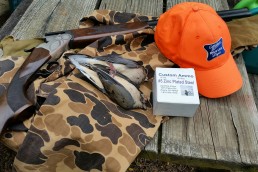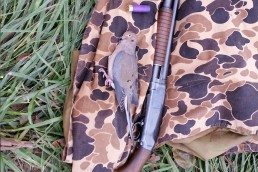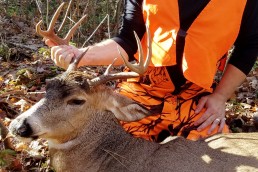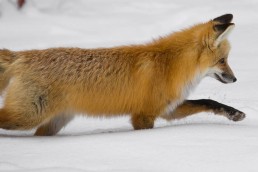Hunting Doves after Opening Day
SHARE THIS POST
Our four-dozen goose decoys were set in the corn stubble, along with a dozen or so field mallard decoys. Only three days before, big, migrating flocks of Canada geese had been working this field. Today, the geese came out of the Horicon Marsh, and decided to feed elsewhere. Flocks of migrating mourning doves were a different story! Flock after flock of 15 to 25 doves would circle the Mojo duck “spinner” set by the mallard decoys. After prime time for waterfowl was over, we switched from loads of BB to steel #3 shot and managed to scratch down a few doves. I can only imagine how many doves we would have harvested had we been set up with dove decoys!
Wisconsin has a resident population of mourning doves (Zenaida macroura) that numbers about seven million. In addition to those doves, another estimated six to seven million migrate through Wisconsin on their way south. Hunting pressure on opening weekend of dove season can be intense! Resident dove populations take a beating. Hunters have the local water holes and feeding fields scouted out. Few other seasons are open, so doves are pursued with a passion! I hunt doves opening weekend like everyone else. However, my dove decoys and Mojo “spinner” don’t get put away until after the season closes. Find a field those big flocks of migratory doves are working, and you will have a hot-barrel day!
Another dove being seen more and more often is the Eurasian collared dove (Streptopelia decaocto). This invasive species found it’s way into the US in the 1980s and it has expanded its range into Wisconsin. They resemble a common mourning dove, but are about 1 1/2 times as big. They have a distinctive ring resembling a collar, and, yes, they are legal game, per a DNR Wildlife Biologist and a game warden I talked to. I’ve harvested one so far, and they are as tasty as regular doves.
When to hunt
We start looking for big flocks of doves on fields around the second week of October. As the season progresses, you will notice fewer pairs and single doves, and more flocks. Flocks of five to seven birds are common. These smaller flocks seem to join up with others as the season progresses. Last year, I was squirrel hunting near some cut cornfields in Southeast Iowa. It was the last week of October, and I saw flocks of migrating mourning doves numbering between 50 and 100 birds landing in the corn stubble. The squirrel hunt turned into a dove hunt. However, lack of decoys and the end of shooting hours limited my take. Generally, you want a freshly picked grain field, bordered by a fenceline with trees or an adjacent woods. Doves will often stage in the trees before flying out to feed. Pre-hunt scouting of fields will save you a lot of time.
Are you enjoying this post?
You can be among the first to get the latest info on where to go, what to use and how to use it!
Decoys
Use as many as you can. Set the decoys out in the open, where they can be seen by passing doves. Set some in the trees near your blind, and others out by your motion decoy. If hunting corn stubble, perch a decoy or two up on the stalks. We set decoys in an X shape, as it provides multiple open “landing zones” for incoming birds. Set your motion decoy in the middle of the X. Another trick we like to use is setting out a pair of pigeon decoys, next to the dove decoys. Pigeons often feed with doves in agricultural areas. The larger, more colorful pigeon decoys stand out better than drab dove decoys. Another advantage to this, is that we have also killed feral pigeons on our dove hunts. Don’t have any pigeon decoys? Use a pair of mallard field decoys.
Picked grain or cornfields with puddles of standing water are dove magnets. Set your decoys right on the water’s edge. Once again, this is where pre-hunt scouting pays off. I hunted a partially flooded picked cornfield, and killed ducks, geese, doves, and pigeons all on the same weekend out of it.
Loading up
Hunting doves on public land, or in conjunction with waterfowl, mandates the use of steel shot. Use one-ounce loads of size 6 steel. These are fairly inexpensive. I’ve killed doves and barn pigeons with this load over decoys. If hunting under windy conditions, pass shooting, or if ducks are sharing the area with doves, switch to heavier loads of size 3 or 4 steel. If hunting only doves on private land, lead shot is legal. Try a 1-1/8-ounce trap load of size 7 1/2 shot for doves or pigeons over decoys. On my Iowa hunt, I ended up using 16-gauge, one-ounce loads of lead #6 shot I had along for squirrels. These knocked doves down just fine.
My advice is to stick with the doves after opening weekend. Sure, all the dumb birds will be gone, but having a flock or twenty or so doves hovering over the decoys makes for an exciting hunt. We often set up a few dove decoys and a “spinner” off to the side of our waterfowl decoys. Doves can make for some exciting bonus shooting after the waterfowl stop flying for the day.
MWO
SHARE THIS POST
Did you enjoy this post?
You can be among the first to get the latest info on where to go, what to use and how to use it!
Ron Stresing
Ron Stresing has fished since age 4 and hunted since age 12, with a lifelong passion for both. He tries to convey the lessons learned over a lifetime of hunting and fishing in Wisconsin. He also writes a column on shotguns for On Wisconsin Outdoors.




